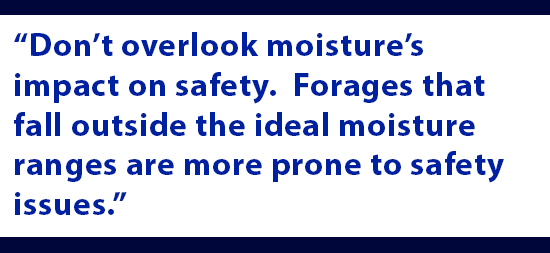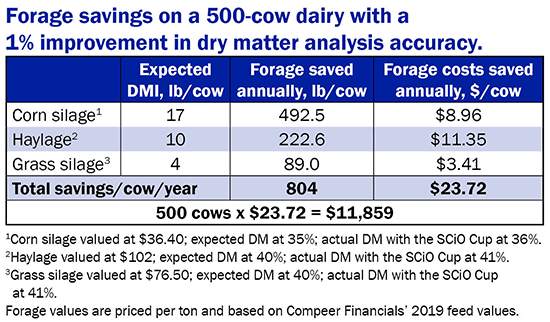
Moisture testing saves money each and every day
 By Nathan Hrnicek
By Nathan Hrnicek
Forage moisture is tested daily on some farms while other farms wait for a nutritionist visit. Farms tend to focus on it more during harvest, but harvest testing strategies also vary farm-to-farm. However, an accurate reading of moisture content is absolutely necessary at several points throughout the year on a dairy farm.
In the field
Correct moisture content is critical to achieving optimal forage fermentation and storage. A large section of corn silage is harvested between 62% and 68% whole-plant moisture. For haylages, a range of 55% to 65% moisture is widely adapted. High-moisture corn, small grains, and grasses have their own ideal moisture content for harvest and storage.
During the last few years, I witnessed many instances where corn’s whole plant moisture and kernel moisture were considerably different. I do not recommend using only the milkline to determine harvest date as too many other factors affect the dry down of the crop.
Knowing moisture content just before harvest begins may also help you adjust your inoculant strategy. For example, as forages get drier, it may become more difficult to maintain the anaerobic stability of the feed. This may warrant the use of a Lactobacillus buchneri inoculant. Because they are more difficult to pack, drier forages may also require adding a pack tractor on a bunker or pile or tightening the brakes on a bagger.
 Don’t overlook moisture’s impact on safety. Forages that fall outside the ideal moisture ranges are more prone to safety issues.
Don’t overlook moisture’s impact on safety. Forages that fall outside the ideal moisture ranges are more prone to safety issues.
Mixing rations
As we feed through stored forages, we know moisture will change. Consider that the stratification on slopes is less than in the middle of piles, so the moisture variance is typically higher. Because bags are filled load-by-load, moisture levels can vary daily. Tower silos feed out like bags.
Weather impacts moisture as well. As rain and snow events occur, it is critical to collect accurate moisture measurements for more precise rations and feeding.
Options to measure moisture content
- Labs: Sending samples to a trustworthy forage lab will get the most consistent and accurate results. The challenge is the time between collecting the sample and receiving the results. I recommend submitting samples for complete analysis. If you’re only checking moisture, other options are available.
- Koster tester: This has been a tried-and-true method for many years on farms across the globe. The main challenges with the Koster tester are the time it takes to complete the test and the additional cooking needed to verify results, which ultimately impacts a farm’s labor demands.
- Air fryers, microwaves and dehydrators:These have varying time points to completion and often don’t have the best longevity.
- Near-infrared technology (NIR): On-farm NIR technology yields results in less than 15 seconds and has shown great progress in accuracy and precision comparable to other on-farm methods.
Testing pays
The table below shows the forage savings on a 500-cow dairy with a 1% improvement in accuracy of moisture content. In this example, a 500-cow dairy saves $11,859 annually. That improvement also means you can more accurately feed ingredients and keep cows performing at their best.

This article was originally written for the April 10, 2021, issue of Hoard’s Dairyman.
About the author: Nathan Hrnicek was a Vita Plus forage consultant, working closely with producers and Vita Plus and dealer staff throughout the central U.S. He grew up on his family’s 1,200-acre diversified crop and livestock farm. He earned his bachelor’s degree in agricultural economics from Purdue University. Hrnicek built his agronomy and forage expertise through several career experiences in seed sales as well as a sampling laboratory.
| Category: |
Dairy Performance Feed quality and nutrition Forage harvesting Forage inoculants Forage storage and management |

